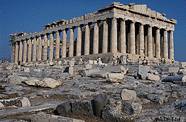
The Parthenon
The Parthenon is one of the many buildings on the Acropolis of Athens. The original building on the site was built as an offering to honor the goddess Athena because the people of ancient Athens believed that she watched over their city. Unfortunately, it was badly damaged by the Persians when they attacked Athens in 480 BC. It sat in ruins after the Persian War because other repairs to the city were needed, so the project of resoring the Parthenon was postponed for about 30 years.
The great Athenian leader Perikles resumed construction in 447 BC. The architects, Iktinos and Kallikrates, decided it would be too much work to repair the old building and decided to completely replace it. In the process they build an architectural masterpiece.
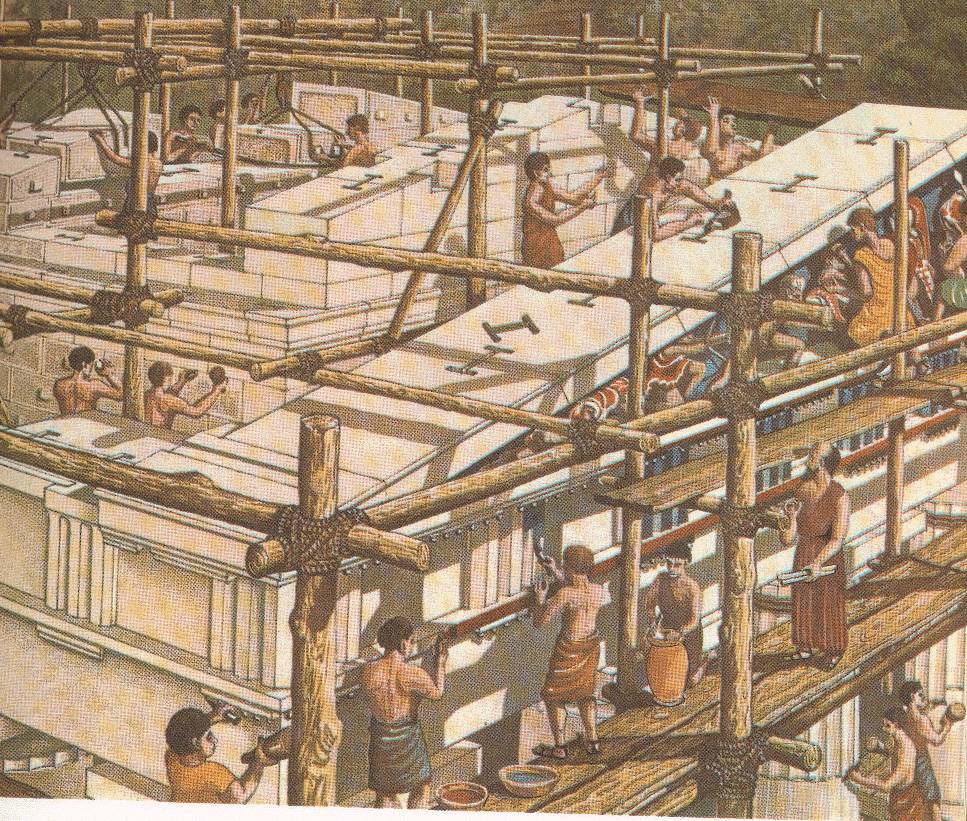
Construction of the Parthenon
The Parthenon is basically a Doirc temple with eight rows of Doric columns along the back and front of the building, and seventeen down each side (counting the corner ones both ways). The six columns in the center are slightly smaller than the outer ones. The Parthenon was divided into two main chambers. In the central area of the smaller of the two inner rooms, stood the famous statue of Athena which was plated with gold and ivory. The building was made of mostly marble, no mortar or cement was used. Each block was accurately measured and cut to fit. Clamps and dowels were used to hold them in place during construction and later they were leaded into place.
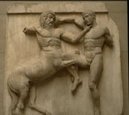
Metope of Laptih fighting a Centaur
The 92 metopes (small squares above the columns on the sides of the building with sculptures on them) found on the Parthenon depicted a series of dual combats between mythical figures. The metopes on the western side show the mythical battle against the Amazons. On the south side is the battle between the Laptihs and Centaurs. On the east side gods and giants fight, and on the north side, the Greeks fight the Trojans.
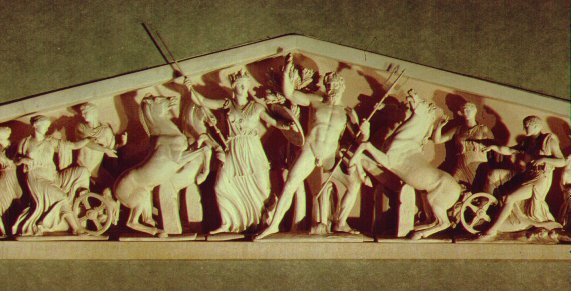
Reconstruction of the east Pediment
On the eastern pediment (the trianglar shapes on the ends of the building below the roof) are images of the story of the birth of Athena. The legend tells about how Zeus wanted the knowledge of Athena's mother, so he turned her into a fly. He ended up swallowing her and when Athena was born his head began to swell as she grew. His head ached more and more so he call upon his blacksmith, Hephaestus, who used one of his tool to crack open Zeus' skull. Out came Athena, born full-grown. The birth of Athena is usually associated with rebirth or starting something new.
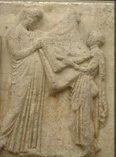
Freize from the south side
On the north and south sides (on the base) heading west to east are mounted horsemen, chariot groups, and citizens of Athens. In front musicians and people with gifts and offerings lead the way.
The Golden Age of Athens ended when Athens and Sparta went to war. Even though the Parthenon survived the attacks on the city, it went though several other changes. About 298 BC Cachares stripped gold plates from the sculpture of Athena to help fight the Romans. In AD 426, the Parthenon was converted into a Christian church. The Christians dedicated it to Hagia Sophia (Holy Wisdom) and in AD 662 they re-dedicated it to the Virgin Mary. In 1460, the Turks turned it into a mosque, and in 1687, the Venetian general, Morosini, used it as a powder magazine. During the war it suffered damage when a cannon shell caused an explosion which destroyed most of the central area and no repairs were ever made again until the 1920s.
Lord Elgin removed most of the damaged sculptures in 1799. They are currently in the British Museum. In 1928, a fund to repair the columns was raised and in 1950, the northern colonnade was repaired. Since that time constant work trying to preserve what is left of the Parthenon has continued.
The Parthenon is a beautiful work of art that shows the power and confident spirit of the Athenians. It is quite a site to see with a lot of history.
Sources:
Leacrott, Helen and Richard. The Buildings of Ancient Greece. New York: William Scott Inc., 1996.
"Parthenon" (CD-ROM) Encata 95. Microsoft, Inc. , 1995.
Silverman, David. " Parthenon" (website) @ http://homer.reed.edu/Parthenon.html, 1/6/00.
Stillwell, Richard. " Parthenon" Colllier. s Encyclopedia, volume #8, 1985.
Picture Credit:
Picture #1 - "Parthenon" from: Mr. Loeser's private slide collection.
Picture #2 - "Construction of the Parthenon" from: The Buildings of Ancient Greece.
Picture #3 - "Metope of Laptih fighting a Centaur" from: The Buildings of Ancient Greece.
Picture #4 - "Pediment Reconstruction" from: Mr. Loeser's private slide collection.
Picture #5 - "Freize from the south side" from: The Buildings of Ancient Greece.